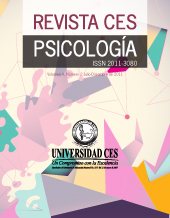The anthropomorphe factor: analysis element of nonverbal communication?
DOI:
https://doi.org/10.21615/cesp.10.2.9Keywords:
Nonverbal Communication, Human Body, Anthropomorphic Factor, Communication PsychologyAbstract
The sizes, forms, proportions and appearance of the human body, i.e. the anthropomorphic factor (AF), has generated worldwide academic disagreement. On one side, there are scientists who include it in the study of nonverbal communication (NVC), on the other hand, there are authors who exclude it. For this reason, the purpose of this article is to elucidate whether the AF is an analytical element in NVC. To this end, a conceptual decantation was necessary through an ontological examination; therefore, this research provides criteria to create a theoretical framework of the AF as subcategory of the NVC. In addition, when reviewing scientific doctrine and research of evolutionary psychologists, it is found that the AF: a) is a non-linguistic sign that sends at least 15 different messages, b) is coupled with the definition of NVC and complies with all its structural elements, c) it can be found as a mechanism of expression in other species and d) it supports the verbal system by executing 4 four functions. Consequently, it is mandatory to continue with experimental research which is limited to communication psychology, in order to explore other AF aspects involved in social cognition.
Downloads
References
Abetz, H., et Wade, J. (1997). Social Cognition and Evolutionary Psychology: Physical Attractiveness and Contrast Effects on Women's Self-perceived Body Image, International Journal of Psychology, 32(1), 35–42. http://dx.doi.org/10.1080/002075997400953
Alicke, M., Smith, R., et Klotz, M. (1989). Judgments of Physical Attractiveness: The Role of Faces and bodies, Personality and Social Psychology Bulletin, 12(4), 381-389. http://dx.doi.org/10.1177/0146167286124001
Ambady, N., Bernieri, F.J., et Richeson, J.A. (2000). Toward a histology of social behavior: Judgmental accuracy from thin slices of the behavioral stream. Advances in Experimental Social Psychology, 32(1), 201-271. http://dx.doi.org/10.1016/S0065-2601(00)80006-4
Andersen, P.A. (2008). Nonverbal Communication: Forms and Functions. Illinois, United States: Waveland Press.
Archer, J. (2009). Does sexual selection explain human sex differences in aggression?, Behavioral and brain sciences, 32(3), 249-266. http://doi.org/10.1017/S0140525X09990951
Bacáicoa, F. (2006). Psicología evolutiva y psicología evolucionista claves para la discusión. Revista de Psicodidáctica, 11(1), 109-131. Repéré à http://www.redalyc.org/articulo.oa?id=17514747008
Bernard, F. (2015). Les théories de l’influence en communication: perspectives nord-américaines et françaises, Hermès, La Revue, 1(71), 45-57. Repéré à https://www.cairn.info/resume.php?ID_ARTICLE=HERM_071_0045
Bereczki, T., et Mesko, N. (2006). Hair length, facial attractiveness, personality atribution : A multriple fitness model of hairdressing, Psychology Review, 15(1), 35-42. Repéré à http://mjesec.ffzg.hr/revija.psi/vol%2013%201%202006/Bereczkei_2006_13-1.pdf
Berscheid, E., Dion, K., Walster, E., et Walster, G.W. (1971). Physical attractiveness and dating choice: A test of the matching hypothesis. Journal of Experimental and Social Psychology, 7(2), 173-189. http://dx.doi.org/10.1016/0022-1031(71)90065-5
Blaker, N.M., Rompa, I., Dessing, I.H., Vriend, A.F., Herscheberg, C., et Van Vugt, M. (2013). The height leadership advantage in men and women: Testing evolutionary psychology predictions about the perceptions of tall leaders. Group Processes & Intergroup Relations, 16(1), 17–27. Repéré à http://journals.sagepub.com/doi/pdf/10.1177/1368430212437211
Boutaud, J. (2004). Sémiotique et communication: Un malentendu qui a bien tourné. Hermès, La Revue, 38(1), 96-102. Repéré à http://documents.irevues.inist.fr/handle/2042/9431
Braun, M. F., et Bryan, A. (2006), Female waist-to-hip and male waist-to-shoulder ratios as determinants of romantic partner desirability. Journal of Social and Personal Relationships, 23(5), 805-819. Repéré à http://www.unm.edu/~abryan/articles/femalehipratio.pdf
Buss, D. (2016). Evolutionary psychology: The new science of mind. New York, United States: Routhledge.
Casans, A. (2001). Aspectos estéticos de la divina proporción, (thèse en doctorat, Universidad Complutense de Madrid). Repéré à http://biblioteca.ucm.es/tesis/fsl/ucm-t25388.pdf.
Casablanca, L., et Chacón, P. (2014). La moda como lenguaje: una comunicación no verbal. Revista de la Asociación Aragonesa de Arte, 29(2), 1-10. Repéré à http://www.aacadigital.com/contenido.php?idarticulo=1030
Castro I., Lazzari, A.P., Moresca, R., Petrelli, E., et Rodrigues, K. (2012). Photometric study of divine proportion and its correlation with facial attractiveness. Dental Press Journal, 17(2), 1-22. http://dx.doi.org/10.1590/S2176-94512012000200022
Chi-yue, C., et Qiu, L. (2014). Communication and culture: A complexity theory approach. Asian Journal of Social Psychology, 17(1), 108–111. http://dx.doi.org/10.1111/ajsp.12054
Clavien, C. J., El-Bez, C., Berthoud, A., Clément F., Dekeuwer C., Deonna, J., . . . Perrin, N. (2007). Moral et evolution biologique: entre déterminisme et liberté. Laussanne, Suisse: Presses Polythechniques et Universitaires Rommandes.
Cosnier, J. (1996). Le geste du dialogue, La communication non verbale. Repéré à http://icar.univ-lyon2.fr/membres/jcosnier/articles/II-9_Les_gestes_communication.pdf
Croussy, G. (1989). La génération de la communication. Lille, France: Presses Universitaires de Lille.
Daly, M., et Wilson, M. (1999). Human evolutionary psychology and animal behavior. Animal Behaviour, 57(1), 509–519. http://dx.doi.org/10.1006/anbe.1998.1027
De Lavergne, C. (2010). La communication non verbale. Repéré à http://www.univ-montp3.fr/infocom/wp-content/REC-La-communication-non-verbale2.pdf
De Waal, F. (2002). Evolutionary psychology: The wheat and chaff. American Psychological Society, 11(6), 187-191. Repéré à http://www.emory.edu/LIVING_LINKS/publications/articles/deWaal_2002.pdf
Dixson, A. F. (2012). Primate Sexuality: Comparative Studies of the Prosimians, Monkeys, Apes, and humans. (2e ed.). New York, United States: Oxford.
Dixson, B.J., et Vasey, P.L. (2012). Beards augment perceptions of men's age, social status, and aggressiveness, but not attractiveness. Behavioral Ecology, 23(3), 481-490. https://doi.org/10.1093/beheco/arr214
Dixson, B.J., et Brooks, R.C. (2013). The role of facial hair in women's perceptions of men's attractiveness, health, masculinity and parenting abilities. Evolution and Human Behavior, 34(2), 236–241. http://dx.doi.org/10.1016/j.evolhumbehav.2013.02.003
Duarte, E. (2003). Por uma epistemologia da comunicação. Dans Lopes, M. I. V. (dir.), Epistemologia da comunicaçâo (2e éd., vol. 1, p. 41-54). Sâo Paulo, Brésil: Loyola.
Fast, J. (1979), El lenguaje del cuerpo. Barcelona, España: Kairos.
Faucher, L., et Poirier P. (2010). Psychologie évolutionniste et théories interdomaines. Dialogue, 40(03), 453-486. https://doi.org/10.1017/S0012217300018874
França, V. (2002). Paradigmas da comunicaçâo: conhecer o quê?. Dans Motta, L. G.; Weber, M. H.; França, V. et Paiva, R. (dir.), Estratégias e culturas da comunicaçâo (3e éd., vol. 2, p. 13-29). Brasil, Brasilia: Editora Universidade de Brasilia.
Forrester, G., Quaresmini, C., Leavens, D., Mareschal, D., et Thomas, M. (2013). Human handedness: An inherited evolutionary trait. Behavioral Brain Research, 237(1), 200-206. http://dx.doi.org/10.1016/j.bbr.2012.09.037
Garcia, J. L. (2000). Comunicación no verbal, periodismo y medios audiovisuales. Madrid, España: Universitas.
Goldberg, J. (2010). Ethologie animale et humaine. Paris, France: Frison-Roche.
Goldstein, B. E. (2009). Sensation & Perception. San Francisco, United States: Thomson.
Hall, E.T. (1984). Le langage silencieux. Paris, France: Seuil.
Hargie, O. (2011). Skilled Interpersonal Communication. New York, United States: Routledge.
Hensley, W. E. (1994). Height as a basis for interpersonal attraction. Adolescence, 29(114), 469-474.
Hernández, M., et Rodríguez, I. (2009), Investigar en comunicación no verbal: un modelo para el análisis del comportamiento kinésico de líderes políticos y para la determinación de su significación estratégica. Enseñanza & Teaching, 27(1), 61-94. Repéré à http://campus.usal.es/~revistas_trabajo/index.php/0212-5374/article/viewFile/6584/7150
Johnson, K. L., Iida, M., et Tassinary, L. G. (2012). Person (mis)perception: Functionally biased sex categorization of bodies. Proceedings of the Royal Society, Biological Sciences, 279(1749), 4982- 4989. http://dx.doi.org/10.1098/rspb.2012.2060
Jones, B. C., Little, A. C., Penton-Voak, I. S., Tiddeman, B. P., Burt, D. M., et Perrett, D. I. (2001). Facial symmetry and judgements of apparent health: support for a ‘good genes’ explanation of the attractiveness symmetry relationship. Evolutionary Human behavior, 22(6), 417–429. http://dx.doi.org/10.1016/S1090-5138(01)00083-6
Keating, C. F., Mazur, A., et Segall, M. H. (1981). A cross-cultural exploration of physiognomic traits of dominance and happiness. Ethology and Sociobiology, 2(1), 41-48. http://dx.doi.org/10.1016/0162-3095(81)90021-2
Knapp, M. L. (1995). La comunicacion no verbal, el cuerpo y el entorno, Barcelona, España: Paidos.
Kruger, D.J. (2006). Male facial masculinity influences attributions of personality and reproductive strategy, Journal of Social and Personal Relationships, 13(4), 451–463. http://dx.doi.org/10.1111/j.1475-6811.2006.00129.x
Korpikiewicz, H. (2004). Non verbal communication vs awareness, Lingua ac Communitas, 14(1), 13-19. Repéré à http://www.lingua.amu.edu.pl/Lingua_14/KORPIKIEWICZ_14.pdf
Kwon, J., Ogawa, K., Ono, E., et Miyake, Y. (2015). Detection of Nonverbal Synchronization through Phase Difference in Human Communication, PLoS ONE, 10(7), 1-15. http://dx.doi.org/10.1371/journal.pone.0133881
Lecalennier, F. (2007). Evolución & psicología: El caso de la psicología evolucionista. Revista de neuropsicología de Chile, 2(2), 56-71. Repéré à http://www.redalyc.org/pdf/1793/179317753003.pdf
Leathers, D., et Eaves, M. H. (2016). Successfull non verbal communication: Principles and applications. New York, United States: Routledge.
Little, A.C., Jones, B.C., et DeBruine, L.M. (2011). Facial attractiveness: evolutionary based research, Philosofical Transaction of Royal society: Biological sciences, 366(1), 1638–1659. http://dx.doi.org/10.1098/rstb.2010.0404
Little, A.C., et Robert, S.C. (2012). Evolution, Appearance, and Occupational Success. Evolutionary Psychology, 10(5), 782-801. http://dx.doi.org/10.1177/147470491201000503
Maestripieri, D. (2012). Comparative Primate Psychology, repéré à http://primate.uchicago.edu/2012CPP.pdf
Mesko, N., et Bereczkei, T. (2004). Hairstyle as an adaptive means of displaying phenotypic quality, Human Nature, 15(3), 251-270. http://dx.doi.org/10.1007/s12110-004-1008-6
Mc Entee, E. (2004). Comunicación Oral. México DF, México: Mc Graw-Hill.
McMillan, O., Monteiro, A., et Kapan, D. (2002). Development and evolution on the wing. Trends in Ecology and Evolution, 17(3), 125-133. http://dx.doi.org/10.1016/S0169-5347(01)02427-2
Owen, H. (2011). Skilled Interpersonal Interaction: Research, Theory, and Practice. London, England: Routledge.
Perrett, D. I., Burt, D. M., Penton-Voak, I. S., Lee, K.J., Rowland, D. A., et Edwards, R. (1999). Symmetry and human facial attractiveness. Evolutionary and Human Behavior, 20(5), 295–307. http://dx.doi.org/10.1016/S1090-5138(99)00014-8
Pons, C. (2015). Comunicación no verbal. Barcelona, España: kairós.
Rastier, F. (1998), Le problème épistémologique du contexte et le statut de l'interprétation dans les sciences du langage, language, 98(129), 97-111.
Richard, J., Bonnet, C., Ghiglione, R., Bromberg, M., Beauvois, J., Doise, W., et Deschamps, J. (1990). Traité de psychologie cognitive: cognition, représentation, communication. Paris, France: Dunod.
Ricœur, P. (2006). Le conflit des interprétations. Essais d'herméneutique II. Paris, France: Le Seuil.
Rhodes, A. (2006). The Evolutionary Psychology of Facial Beauty. Annual Review of Psychology, 57(1), 199-226. http://dx.doi.org/10.1146/annurev.psych.57.102904.190208
Rhodes, G., Proffitt, F., Grady, J., et Sumich, A. (1998). Facial symmetry and the perception of beauty. Psychonomic Bulletin & Review, 5(4), 659–669. http://dx.doi.org/10.3758/BF03208842
Robertson, K.A., et Monteiro A. (2005). Female Bicyclus anynana butterflies choose males on the basis of their dorsal UV-reflective eyespot pupils. Proceedings of the Royal Society B: Biological Sciences, 272(1572), 1541-1546. http://dx.doi.org/10.1098/rspb.2005.3142
Robles, C., Hernandez, F. et Fajardo, G. (2011). La comunicación humana y su relación con la queja médica. Conamed, 16(3), 141-147.
Rodríguez, J. (2015). Aproximación al factor antropomorfo: el cuerpo como estímulo en la comunicación no verbal (thèse de license inédit). Institución Universitaria Politécnico Grancolombiano.
Setchell, J. M., et Wickings, E. J. (2005). Dominance, status signals and coloration in male mandrills (Mandrillus sphinx). Ethology, 111(1), 25–50. http://dx.doi.org/10.1111/j.1439-0310.2004.01054.x
Shepperd, J. A., et Strathman, A. J. (1989). Attractiveness and height: The role of stature in dating preference, frequency of dating, and perceptions of attractiveness. Personality and Social Psychology Bulletin, 15(4), 617-627. http://dx.doi.org/10.1177/0146167289154014
Société Académique pour l'Étude des Langue Romances (SAELR). (2009). Dictionnaire pour l´étude avancé des Langues Romances (2e éd., vols. 1-27), Bordeaux, France: SAELR.
Spielmann, G. (2011). Théorie(s) de la communication le modèle classique à six éléments. Repéré à http://faculty.georgetown.edu/spielmag/docs/comm/commschema.htm
Stulp, G., Buunk, A. P., Verhulst, S., et Pollet, T. V. (2012). High and mighty: Height increases authority in professional refereeing. Evolutionary Psychology, 10(1), 588-601. Repéré à http://journals.sagepub.com/doi/full/10.1177/147470491201000314
Thornhill, R., et Gangestad, S. W. (2006). Facial sexual dimorphism, developmental stability, and susceptibility to disease in men and women. Evolutionary and Human Behavior, 27(2), 131–144. http://dx.doi.org/10.1016/j.evolhumbehav.2005.06.001
Vigotsky, L.S. (1962). Thought and Language. Cambridge, England: MIT Press
Wong, E. M., Ormiston, M. E., et Haselhuhn, M. P. (2011). A face only an investor could love: CEOs' facial structure predicts their firms' financial performance. Psychological Science, 22(1), 1478-1483. http://dx.doi.org/10.1177/0956797611418838
Xu, Y., Lee, A., Wing-Li, W., Liu, X., et Birkholz, P. (2013). Human Vocal Attractiveness as Signaled by Body Size Projection. Plos One, 8(4), 1-9. http://dx.doi.org/10.1371/journal.pone.0062397
Downloads
Published
How to Cite
Issue
Section
License
Copyright (c) 2017 Jonathan Rodríguez Jaime, Michel B. Cislak

This work is licensed under a Creative Commons Attribution-NonCommercial-ShareAlike 4.0 International License.
Each manuscript is accompanied by a statement specifyingThat the materials are unpublished, that have not been previously published in printed formatElectronic and that they will not be presented to any other means before knowing the decision of the magazine. ThroughoutIn case, any previous publication, sea in printed or electronic form, must be made known to the editorial staffWriting The authors attach a signed statement stating that, and the manuscript is acceptedFor publication, the rights of reproduction are the exclusive property of the Journal CES Psychology.| Article metrics | |
|---|---|
| Abstract views | |
| Galley vies | |
| PDF Views | |
| HTML views | |
| Other views | |




